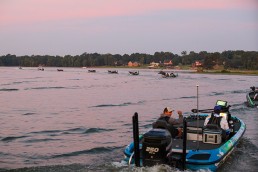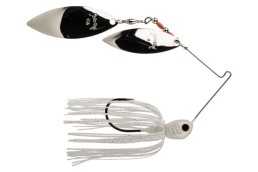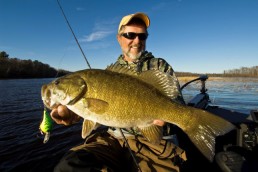Throwback Thursday – Flippin’: A Concept Not Just A Technique – Part 3
By Terry Battisti – Bass Fishing Archives
This is part three of a three-part series on the concept of flipping and the effect it had on the sport. In this final installment, we talked with Hank Parker and Denny Brauer about how the technique changed their careers. To read Part One click here and to read Part Two click here.

Hank Parker
Although Hank Parker may not have designed a lure or piece of equipment having to do with flipping, he is arguably the angler who put the technique on the map for good.
Up until the ’79 Classic on Lake Texoma, flipping wasn’t much more than something serious anglers kept to themselves. Yes, it had been the determining technique to win national events and had been written about in Bass Master Magazine – a six-part series in 1976 –still few anglers had adopted the long rod into their repertoire.
That all changed when Parker won the ’79 Classic – flipping had finally come of age. Parker’s introduction to flipping came early. He was first introduced to it in 1976 when, as he says, “Klein was still in diapers.”
“I saw Dave Gliebe catch 95-15 on Lake Okeechobee in an American Bass event in 1976,” he said. “The conditions for that tournament were horrible and it blew my mind that he could catch that much weight.
“Then six weeks later he won another event on Kentucky Lake under perfect conditions and that really made me think twice about the technique. It was something that worked in all conditions. “After those two events, I started doing a lot of research on the technique and found out that it was invented by Dee Thomas.”
“What really intrigued me about it was how well the technique could illicit a reaction strike,” he said. “My dad had always taught me that fish won’t chase a bait down all the time. Sometimes you have to hit them on the head and make them strike out of aggression or territorial rights. Plus, in muddy water, where their field of vision is limited, you sometimes have to hit them on the head – get in their face. There’s never been a better method than flipping for doing that.”
“A lot of times during cold-front conditions, the fish bury themselves in the cover and they’re not in an aggressive mood. Back before flipping, who knew you could take a 7- or 8-foot rod and place a lure right on top of their head and get a reaction strike out of them?”
As stated earlier, Parker’s ’79 Classic victory put flipping on the national map. Although Basil Bacon got second, also flipping, the event could have had a different result for a couple of reasons.
“That Classic would have turned out a lot differently if not for two events,” Parker said. “First, the water was perfect for throwing a blade and that’s a bait I’d had great success with over the years.”
“I’d been throwing it without much success and then I ran into Forrest Wood. He told me he’d caught two fish flipping and lost a couple of others. After that, I fished an incredible area and didn’t get a bite on the blade. I thought to myself, ‘They had to be there.’ I went back and flipped the same area I’d just gone through and caught three fish on four
flips. I had 11 or 12 pounds which was amazing for Texoma at the time.”
“By 10:30 in the morning, I had 16 pounds and left it alone. In the process, I’d also broken my only flipping stick, a prototype that I was testing, and had to switch to a 6-foot pistol-grip rod. I caught a couple fish using that rod but it was by no means the right equipment.”
“After the weigh-in, I went to Harold Sharp and asked him if I could get another rod. Back in those days, you were given a weight limit on tackle and a limit on the number of rods you could use. Because I had brought a flipping stick with me, Harold decided it would be okay if I went out and got another rod. Back then, though, you couldn’t find a flipping stick at most tackle shops.”
“I knew Gary [Klein] had a few so I went and asked him if I could borrow one of his. He said yes and that’s what helped me win. Gary really came to my rescue. I really doubt I could have won it if I had to fish that 6-foot rod.”
Denny Brauer

1984.
Dee Thomas may have invented the technique, Dave Gliebe may have been the first person to really utilize it east of the Mississippi, Gary Klein and Basil Bacon may have made strides in tackle developed specifically for the technique and Hank Parker may have been the angler who really cemented its place in the sport. It would be tough to argue, though, if there’s ever been another angler over the course of time that’s made more money flipping than Denny Brauer. He’s third on the all-time winners list with 17 Bass Master victories and 37 top-3 finishes. Not only that, he designed the first tube specifically for flipping.
Brauer’s career started in Nebraska as a Federation angler and fishing the now-defunct U.S. Bass circuit in the mid-to late-70s. He learned of the flipping technique from a six-part series published in Bass Master Magazine written by Dee Thomas and Dave Gliebe through Dave Myers. Although he wouldn’t know it for some time, that series would change his life.
“Flipping first came to my attention in Bass Master Magazine around 1976,” he said. “I couldn’t get a Flippin’ Stik but a friend of mine made a couple of them out of long rods and I went out with him in his boat and used one. Then I bought my first flipping stick, a Bass Pro Shops rod called The Dabbler.”
“There weren’t many people around here that flipped so I had no choice but to learn it on my own through trial and error,” he said. “I practiced flipping and pitching a bunch and within a year got fairly decent at it. It played a part in a lot of bass club wins right off the bat. “It was deadly on the chain of lakes I was fishing at the time,” he said. “I was fishing for fish that a lot of anglers weren’t targeting.”
“The watersheds lakes we competed on in Nebraska back then had lots of cover and were great for the flipping method.”
The technique helped him make the ’78 and ’80 Federation Nationals, which is what jump-started his national debut with BASS. It’d take him two years to make the Classic and another two to win his first event but he was sold on the power of flipping.
“When I started fishing the BASS events in 1980, almost everyone was flipping,” he said. “I remember the first national event I won on Sam Rayburn (TX, 1984). All the fish I caught were on flipping and pitching techniques. The fish were on the deeper willows and you had to be really precise. I landed a very high percentage of my bites that event”
Brauer was never content with the status quo with the technique, though. “The main baits we used back in the early days were jigs, worms, and lizards,” he said. “Tubes were out but no one liked to fish them because they were too short and they were single-walled baits and that didn’t stay on the hook very well. They’d always want to slide down the hook. You had to improvise a lot in order for them to be effective.”
“Then I won the ‘98 Classic on High Rock and that changed everything. “I’d been on a good flip bite with jigs and worms before the lake went off limits but when I went back for the one-day official practice, the fish wouldn’t eat the jig. I don’t know what happened but the fish changed. It really surprised me because the fish were locked on the jig the month before.”
“I changed up to a tube and they ate it. The forage the fish were eating was the same size as the tube and they keyed in on that size difference. “After the Classic, I met with the folks down at Strike King and they let me design the first flipping tube.”
The ’98 season provided more than his Classic win, though. In all, he won four BassMaster events in which flipping played a role in two of them. He became known as the preeminent flipper. During the interview, I had a chance to ask him how he felt the technique has changed over the years.
“The gear has made it a lot easier to flip all day compared to what we had when I first started,” he said. “My first actual flipping stick was that Bass Pro Shops Dabbler.’ I broke that rod so many times but it was a great rod. The only problem was it was so heavy. You had to be in shape to fish it all day long. The funny thing right now is I’m meeting with a major retailer about a new line of rods I’m launching with Ardent. They’re so much lighter than that old Dabbler. Today’s rods are at a completely new level now compared to the old days.”
“Also back then there was only one flipping stick size, action, and power. Today anglers can choose from a number of different rods to fit what they need at the time. For example, I’ve designed four separate flipping sticks for Ardent ranging from a 7’-4” light flipping stick to a 7’-10” heavy action rod.”
“The reels have also come a long way,” he said. “The Ardent F700 has a Perma-Lock Drag System and nose cone (no level wind) that allows anglers to pitch a jig a lot farther than a standard-style reel. Plus, the narrow spool doesn’t waste a lot of line.”
“With the tackle today anglers are spoiled with how light, sensitive and responsive the gear is. It used to be the rod would work against you.”
Brauer will forever be known in the world of bass fishing as one of the best flippers the sport has ever produced. I was interested in hearing from him how he felt the technique played a role in his career.
“Without a doubt, it did a lot for me,” he said. “Not just for winning and placing but it also played a major role in marketing myself. Flipping has made my career a lot easier. In fact, when I started out I figured I’d be a blade guy. I guess it didn’t turn out that way.”
























